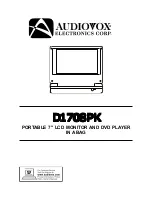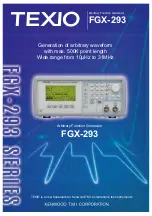
Not
for
Reproduction
Not for
Reproduction
6 BRIGGSandSTRATTON.COM
Operator Safety
Equipment Description
Read this manual carefully and become familiar with your
generator. Know its applications, its limitations and any
hazards involved.
The generator is an engine–driven, revolving field, alternating current (AC)
generator. It was designed to supply electrical power for operating compatible
electrical lighting, appliances, tools and motor loads. The generator’s revolving
field is driven at about 3,600 rpm by a single-cylinder engine.
Every effort has been made to ensure that the information in this manual is both
accurate and current. However, the manufacturer reserves the right to change,
alter or otherwise improve the generator and this documentation at any time
without prior notice.
Important Safety Information
The manufacturer cannot possibly anticipate every possible circumstance that
might involve a hazard. The warnings in this manual, and the tags and decals
affixed to the unit are, therefore, not all-inclusive. If you use a procedure, work
method or operating technique that the manufacturer does not specifically
recommend, you must satisfy yourself that it is safe for you and others. You must
also make sure that the procedure, work method or operating technique that you
choose does not render the generator unsafe.
Safety and Control Symbols
The safety alert symbol indicates a potential personal injury hazard. A
signal word (DANGER, WARNING, or CAUTION) is used with the alert
symbol to designate a degree or level of hazard seriousness. A safety symbol
may be used to represent the type of hazard. The signal word
NOTICE
is used
to address practices not related to personal injury.
DANGER
indicates a hazard which, if not avoided,
will
result in death or
serious injury.
WARNING
indicates a hazard which, if not avoided,
could
result in death
or serious injury.
CAUTION
indicates a hazard which, if not avoided,
could
result in minor
or moderate injury.
NOTICE
address practices not related to personal injury.
WARNING
Starter cord kickback (rapid retraction) will pull hand and
arm toward engine faster than you can let go which could cause
broken bones, fractures, bruises, or sprains resulting in serious
injury.
• When starting engine, pull cord slowly until resistance is felt and then pull
rapidly to avoid kickback.
• NEVER start or stop engine with electrical devices plugged in and turned
on.
Suffocation
Fire
Toxic Fumes
Explosion
Electrical
Shock
Kickback
Suffocation
Operator’s
Manual
Moving Parts
Flying Objects
Hot Surface
Heavy Objects
Carbon
Monoxide Alarm
Alarm
Floating
Neutral
Ground
Terminal
Choke
Run
Off
On
Hour Meter
Oil Level
Fuel
Start
Circuit Breaker
Engine Control
Do Not Start
Engine
!
WARNING
POISONOUS GAS HAZARD. Engine exhaust contains
carbon monoxide, a poisonous gas that could kill you in minutes.
You CANNOT see it, smell it, or taste it. Even if you do not smell
exhaust fumes, you could still be exposed to carbon monoxide
gas. If you start to feel sick, dizzy or weak while using this product, shut it off
and get to fresh air RIGHT AWAY. See a doctor. You may have carbon
monoxide poisoning.
• Operate this product ONLY outside far away from windows, doors and
vents to reduce the risk of carbon monoxide gas from accumulating and
potentially being drawn towards occupied spaces.
• Install battery-operated carbon monoxide alarms or plug-in carbon
monoxide alarms with battery back-up according to the manufacturer’s
instructions. Smoke alarms cannot detect carbon monoxide gas.
• DO NOT run this product inside homes, garages, basements,
crawlspaces, sheds, or other partially-enclosed spaces even if using fans
or opening doors and windows for ventilation. Carbon monoxide can
quickly build up in these spaces and can linger for hours, even after the
product has shut off.
• ALWAYS place this product downwind and point the engine exhaust away
from occupied spaces.
Oil
WARNING
Generator voltage could cause electrical shock or burn
resulting in death or serious injury.
• Use approved transfer equipment to prevent backfeed by isolating
generator from electric utility workers.
• When using generator for backup power, notify utility company.
• DO NOT connect generator to a building’s electrical system.
• Use a residual-current device (RCD) in any damp or highly conductive
area, such as metal decking or steel work.
• DO NOT touch bare wires or receptacles.
• DO NOT use generator with electrical cords which are worn, frayed, bare
or otherwise damaged.
• DO NOT operate generator in the rain or wet weather.
• DO NOT handle generator or electrical cords while standing in water,
while barefoot, or while hands or feet are wet.
• DO NOT allow unqualified persons or children to operate or service
generator.







































